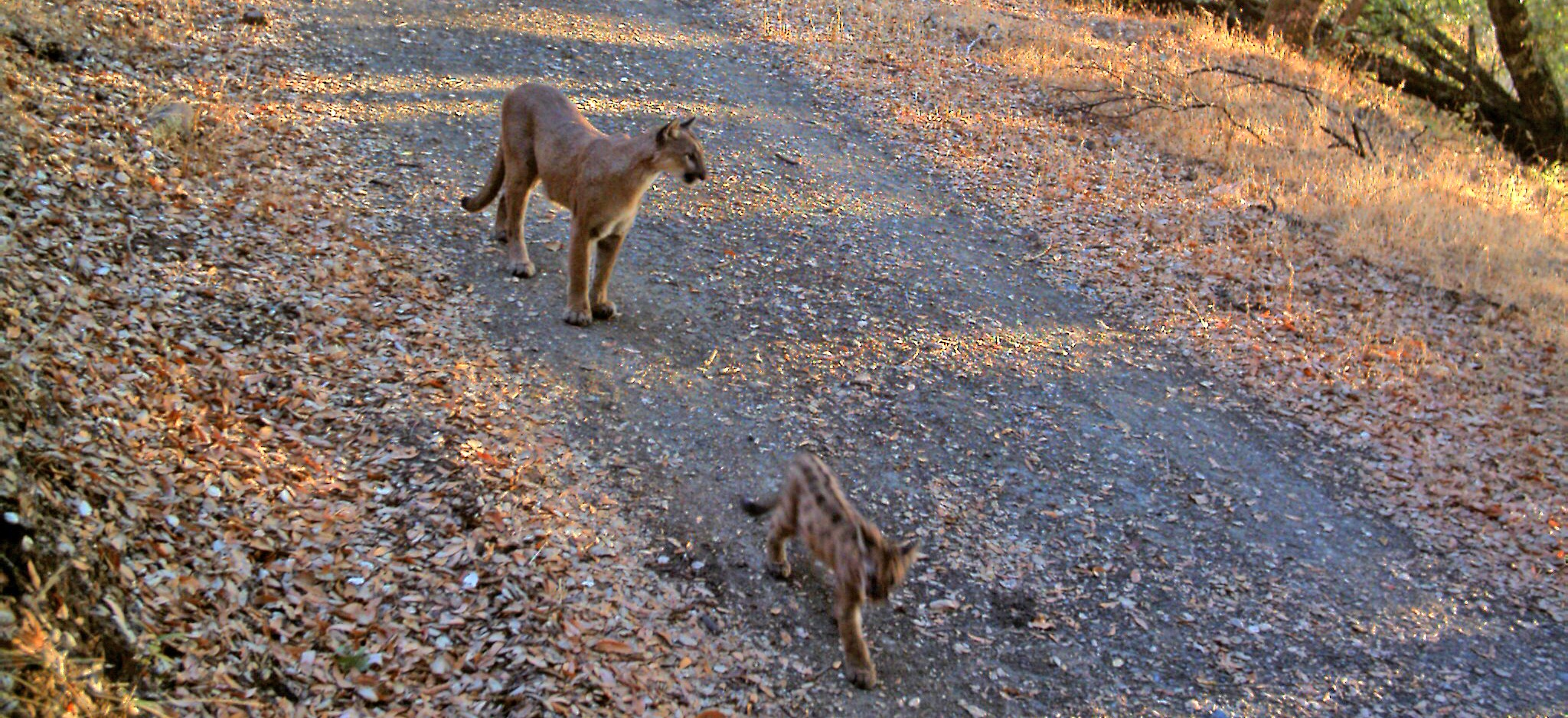The Santa Clara Valley is teeming with wildlife, and a surprising number of these species also happen to be dedicated and hardworking parents. With their impressive range of adaptations, these animals display an array of parenting techniques to assist in the survival and success of their offspring. Keep reading to learn more about these animals and their parenting-styles.

Mountain lion with cub (OSA Wildlife Camera)
Mountain lion
While male mountain lions tend to roam long distances in search of a mate, it is the female mountain lions who shoulder the responsibility of establishing their home ranges for their young. These resilient and self-reliant cats raise their cubs for approximately two years, providing them with the best possible start in life. It is crucial to protect their habitat, as their home ranges may intersect with those of other mothers, ensuring the continued survival of these remarkable creatures. To learn more about mountain lions in the Santa Clara Valley, click here.

Deer with two fawns (Pathways for Wildlife)
Deer
Female deer (doe) are incredible mothers. Just like us humans, many does usually give birth to one baby – the fawn, although certain deer species in the Santa Clara Valley, such as black-tailed deer, are known to have twins. After giving birth, does need to find food while also ensuring the safety of their baby. To do this, they carefully hide their young in tall grass to rest while they forage on different crops, grasses, and vegetation. If you ever come across a young fawn in a preserve, it's important to never approach them. While they appear abandoned, interfering with this process actually puts the fawn at risk, so please trust in the mother doe and leave any babies you may see alone.

Killdeer (Andy Wilson, iNaturalist)
Killdeer
Not only are killdeer avid runners, but they are also fantastic parents. Female and male killdeer share the heavy lifting when it comes to raising their young by taking turns building the nest and incubating their eggs. These birds keep predators away from the nest by putting on a sophisticated performance. When a predator approaches, these birds will fly a short distance, pretending to have a broken wing to look like an easy opportunity for prey. When the predator gets ready to attack, they quickly fly off -- not bad for a bird that’s only 8-11 inches tall.

Red-tailed hawk chicks (David Mauk)
Red-tailed hawks
Red-tailed hawks, like most other hawks, are very hands on at first, but eventually encourage their young to spread their wings and fly...so to speak. These hawks lay two to three eggs per nest, and the mother and father take turns incubating them. Once hatched, the parents trade off duties of keeping hatchlings warm and foraging for food. Once ready to fledge, the parents help them out less and less, and eventually it’s time for the young to hit the road! Some young hawks will try to return to their nest the following year, but the parents will treat them like any other stranger and fight them off. To learn more about red-tailed hawks, click here.

Blue-gray gnatcatcher feeding a cowbird chick (Pam Schodt, Getty Images)
Brown-headed cowbird
Brown-headed cowbirds embrace the more hands...er...wings off...mentality when it comes to parenting. Once hatched, they deposit their eggs into the nest of another nesting bird, known as a “host,” and bank on it not noticing – which they often don’t. This behavior is called “brood parasitism” in the animal kingdom and is the tactic many females use to spend more of their valuable energy on reproducing, rather than rearing.

Common merganser with chicks (Jim McCormac)
Common mergansers
These birds are quite the opposite of brown headed cowbirds – they have large clutches of 9-12 ducklings (but can have up to 70!) and are so good at parenting that they’ll even adopt other ducklings that were abandoned by their parents. Mother mergansers need these babies to be independent, so while she protects her young, they catch all of their own food. The young eat aquatic insects, but as they grow up, they begin to eat fish, mussels, shrimps, and salamanders.

Wolf spider with egg sac (David Mauk)
Wolf spider
These moms have a full-time job, and just like humans, when they have babies, that doesn’t stop! Moms still need to find prey and protect their young from predators, which involves plenty of movement – these critters hunt by stalking and ambushing prey. The mom keeps the egg sac attached to her while she takes care of business, and once they hatch, they move onto her back. If you see one of these critters, never fear! They are harmless to humans and eat bugs, acting as effective pest control.

Virgina opossum with babies (Pixabay)
Virginia opossum
The Virginia opossum is also a busy parent and is the only marsupial in North America, meaning they carry their young in a pouch. They have a litter of around six to nine babies that stay in their mother's pouch for about two months. After that, they crawl onto her back to be carried around. These creatures are excellent at managing pests, as they eat ticks, cockroaches, rats, and mice. Plus, they rarely carry rabies due to their low body temperature. Here's a fun fact: a baby opossum is called a "Joey."
Don’t forget that all of these animals call the open spaces we love home! So, while you’re out and about on your next nature excursion, please exercise caution, and keep a respectful distance from our wild neighbors. To learn more about the interesting wildlife in the Santa Clara Valley, click here.

